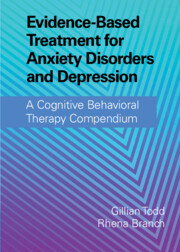 Evidence-Based Treatment for Anxiety Disorders and Depression
Evidence-Based Treatment for Anxiety Disorders and Depression Targeting Intolerance of Uncertainty
from Part One - Cognitive Behavioral Therapy for Anxiety Disorders
Published online by Cambridge University Press: 06 January 2022
This chapter outlines the application of a cognitive behavioral protocol targeting intolerance of uncertainty (CBT-IU) for the treatment of GAD. The theoretical rationale and empirical support for the CBT-IU protocol are presented, followed by an overview of assessment and case conceptualization and a description of each treatment module. Intolerance of uncertainty is viewed as a higher-order cognitive process that drives the development and maintenance of the worry cycle in GAD. Negative beliefs about uncertainty and its consequences are posited to lower the tolerance threshold for the uncertainty in daily life situations, and lead to worry as an attempt to reduce uncertainty through mental planning and preparing. CBT-IU treatment components include (1) psychoeducation and worry awareness training, (2) reevaluation of the usefulness of worry, (3) reevaluation of negative beliefs about uncertainty, identification of safety behaviors, and belief testing through behavioral experiments, (4) problem-solving training and reorientation, (5) written exposure for hypothetical worries, and (6) relapse prevention planning. Each module can be flexibly applied according to a client’s particular presentation. The overarching goal of CBT-IU is to increase tolerance to uncertainty by developing more balanced beliefs about uncertainty and its consequences.
To save this book to your Kindle, first ensure [email protected] is added to your Approved Personal Document E-mail List under your Personal Document Settings on the Manage Your Content and Devices page of your Amazon account. Then enter the ‘name’ part of your Kindle email address below. Find out more about saving to your Kindle.
Note you can select to save to either the @free.kindle.com or @kindle.com variations. ‘@free.kindle.com’ emails are free but can only be saved to your device when it is connected to wi-fi. ‘@kindle.com’ emails can be delivered even when you are not connected to wi-fi, but note that service fees apply.
Find out more about the Kindle Personal Document Service.
To save content items to your account, please confirm that you agree to abide by our usage policies. If this is the first time you use this feature, you will be asked to authorise Cambridge Core to connect with your account. Find out more about saving content to Dropbox.
To save content items to your account, please confirm that you agree to abide by our usage policies. If this is the first time you use this feature, you will be asked to authorise Cambridge Core to connect with your account. Find out more about saving content to Google Drive.